As seen in previous news.utcrops.com blog articles both insects and weather are impacting cotton (Crunch Time for Cotton Insects and Cotton response to saturated soils in West TN), and this article discusses the diseases (fungal, bacterial, and viral pathogens) that may also be impacting cotton. Continue reading
All posts by Heather Marie Kelly, Extension Plant Pathologist
Cotton – fungicide options and if you need them
Cotton is blooming in Tennessee and I’ve gotten some calls asking about fungicides – there are options but none is warranted at this time, but as the rain, heat, and humidity continue we may start to see target spot develop which could justify a fungicide application.
Relatively low disease in Tennessee Corn
With no reports of southern rust in Tennessee (only some in GA and LA reported at this time), it is a relatively quiet disease season in corn, with the exception of grey leaf spot and physioderm brown spot in Tennessee.
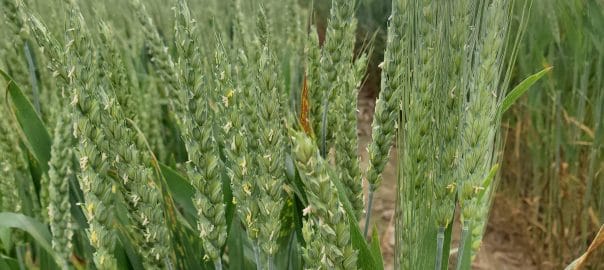
Wheat in bloom – check your scab risk
Wheat is in bloom and when considering a fungicide application one needs to assess their risk for fusarium head blight (FHB) or head scab infection. Continue reading
Fungicide considerations and disease identification in wheat
While I have not heard of any reports of diseases in wheat in Tennessee, as we get closer to flag leaf it will be important to be scouting for diseases. To better guide fungicide decisions, one first needs to correctly identify what disease they are trying to manage. Resources on both disease identification and fungicide selection can be found on the new, mobile-friendly field guide at guide.utcrop.com.
Major diseases of concern include stripe rust and leaf rust of wheat. There have been reports of rust to the south, there’s still not any near Tennessee or its borders. Rust spores usually cannot survive northern winters and have to be blown in from the south each year, (see Figure 1 – wheat rust pathways from http://www.ars.usda.gov/Main/docs.htm?docid=9757 which also contains specific reports on rust in wheat).
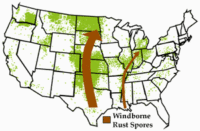
Stripe rust (caused by the fungus Puccinia striiformis) has a cooler, optimal temperature range (50 to 64 °F) and intermittent rain or dew promotes infection and disease development. Stripe rust is best identified by tiny, yellow to bright orange pustules that form distinct stripes on the leaves (Image 1 and 3).
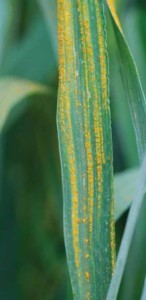
Leaf rust (caused by the fungus Puccinia triticina) has a warmer, optimal temperature range (64 to 77 °F) along with high humidity or moisture to promote infection and disease development. Symptoms of leaf rust include small round or oblong raised pustules that are orange red in color. Leaf rust pustules are more scattered and larger in size compared to stripe rust (Image 2 and 3).
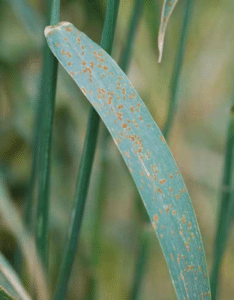
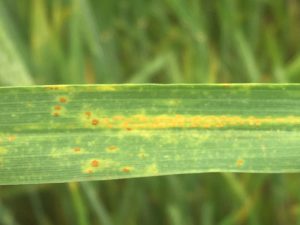
Two other common diseases observed in Tennessee include septoria leaf blotch (Septoria tritici) and stagonospora leaf/glume blotch (Stagonospora nodorum). The leaf lesions look very similar and usually begin in the lower canopy and progress upward, with the latter disease also causing discoloration on the glumes (Image 4 and 5). Some injury, such as fertilizer burn or freeze damage on the leaves, can look very similar to these diseases. Noticing where in the canopy the symptoms are seen and if they are progressing will help distinguish injury from disease. More information on these diseases and others can be found at guide.utcrop.com as well as at UTcrops.com.
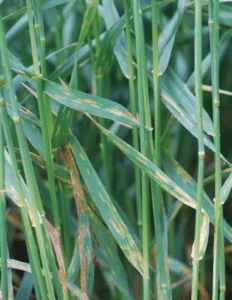
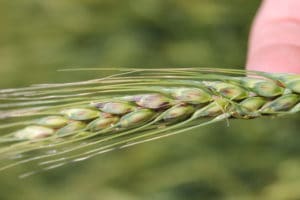
The decision to apply a fungicide to wheat should be based upon multiple factors including: 1) disease presence, 2) fertility and yield potential, 3) weather conditions and 4) cropping history. A detailed foliar fungicide point system can be found at UTcrops.com (Wheat Foliar Fungicide Point System) that can be used as a guide to determine the need for a fungicide application.
Fungicide applications in wheat are most beneficial after the flag leaf has emerged (Feekes 9 or later growth stage), since the flag leaf can make up approximately 75% of the leaf area that contributes to grain fill. Fungicide application can be delayed further if no disease is present and/or there is low disease risk.
The next crucial time period for fungicide application is beginning bloom (Feekes 10.5.1) to protect from Fusarium Head Blight (Head Scab). Consult the Fusarium Head Blight Prediction Center at http://www.wheatscab.psu.edu/ for Head Scab forecasts for your area and the “Wheat Fungicide Table” at UTcrops.com for more information on fungicide products and their efficacy against different wheat diseases. Additional information on wheat can be found at UTcrops.com and on the Wheat Quick Facts – https://news.utcrops.com/wp-content/uploads/2015/10/W321_2015.pdf
What’s Your Type? Understanding the soybean cyst nematode HG Type test and why resistant varieties need to be rotated
Once you’ve sample your field, had it tested, and you have soybean cyst nematode (SCN), you’ll want to consider SCN-resistant varieties, but there are certain populations of SCN that can reproduce on certain SCN-resistant varieties so how do you know what resistant variety is best for your field – you find out the HG Type of your population – a costly test that UT is offering for free this year to TN farmers. Continue reading
After harvest – don’t forget to soil sample!
After harvest is the perfect time to take soil samples not only for nutrient analysis but also to look for pathogens. You’ll never know if you have silent yield robbers lurking in the soil unless you look for them – Take the test, beat the pest! Continue reading
What’s the difference between nematodes?
The last two weeks we’ve published articles highlighting the free soil testing for 2018, which is screening for the ‘silent yield robbers’: pathogenic nematodes and charcoal rot. This article gives a brief description on how pathogenic nematodes differ – their effect on yield and different management options. Continue reading
